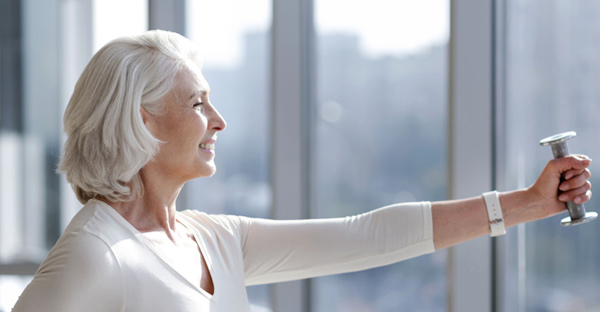

At 60, I was unusually strong and healthy, but my world crashed when my husband Vic was diagnosed with a rare cancer with no risk factors and no cure. We had been vegetarian since our twenties and daily walkers since our thirties. Vic and I began lifting weights in 2000 when I was 55. I was a nutritionist then and soon became a personal trainer since good nutrition and exercise were the best way to assure healthy aging and osteoporosis prevention.
Through Vic’s illness and after his death, caregiver fatigue, stress, and grief challenged my personal health care plan. I didn’t give up for long. I still ate a healthy plant-based diet, even if I sometimes ate too much. I walked most days, although with less intensity than before. Grief weighed me down. I struggled to find the will to do what would help.
Our culture focuses on the outer signs of age—creams and cosmetics, dyes, lifts, and tucks. We assume an aging body weakens and falls apart. It’s true the body changes with age, but like everyone, I had some control over the pace of those changes. Many problems associated with aging, such as osteoporosis, muscle weakness, heart disease, increased blood pressure and diabetes, can be prevented or managed with good self-care.
Exercise produces big results whether we’re 40, 60 or 80. According to the Human Physiology Laboratory at Tufts University Human Nutrition Research Center on Aging, we respond well to exercise at any age. Muscles grow, bones strengthen, and metabolism increases. Our body fat decreases while blood sugar and balance improve. I proved this to myself when I taught strength training at a retirement residence. With modest effort, exercisers in their 80s grew stronger and more vital. We were all delighted.
Reduced muscle strength is associated with age-related disability. The most common cause of muscle weakness is inactivity. After three months of high-intensity muscle training, healthy men over 60 experienced gains similar to those reported for younger men training with similar intensity and duration. People who were stronger remained more independent and less burdened by advancing years.
Any type of exercise helps, but combining aerobics, strength, and flexibility works best. For most people, aerobic exercise is an easy place to begin.
If you aren’t exercising regularly, here’s what worked for me. Begin with a short walk three or four days a week. I slowly increased the time to 30-40 minutes. When that was in place, I increased the pace during the middle part of the walk after a 10-minute warm-up. My body responded best when I didn’t exhaust myself.
In my 30s at a hatha yoga workshop, I noticed the graceful glide and fluid movement of a turbaned woman walking ahead of me. When I entered the classroom, I saw her face. She was at least 80. I was convinced. Many yoga forms increase muscle mass, too.
With aerobics and stretching in place, I substituted strength training for aerobics twice a week. Vic had to convince me to try, but I loved the way I felt once I started. I found trainers I trusted for advice about strength training and safe exercise form. Again, it was important to follow good form and not exhaust myself.
After a few fitful starts following Vic’s death, I returned to strength training twice a week and was amazed by how quickly I regained lost strength. As I gained strength, I was motivated to step up the aerobic pace to more vigorous uphill climbs three times a week. I lost “grief weight,” regained vitality, and felt better about life.
It helped that my clothes fit again.
Nutrition guidelines for healthy aging are the same as those for prevention of cancer, osteoporosis, heart disease, strokes, and diabetes. You’ve heard it before. Increase whole, unrefined plant foods and decrease low-nutrient sugars, fats, and animal products. Increase nutritionally dense dark green and orange vegetables, whole grains, and legumes.
Many are concerned about bone health. Exercise, especially muscle-building exercise, is essential to lowering fracture risk, but we also need supportive nutrients and vitamin D. It’s possible to get adequate vitamin D by brief exposure to the sun, but not if you use sunscreen or live north of the 37th parallel. A study at the Calcium and Bone Metabolism Laboratory at the USDA Human Nutrition Research Center on Aging found that vitamin D supplementation decreased bone loss and fracture risk in older women. The best way to monitor Vitamin D levels is with a blood test. In recent years, Vitamin D testing and Vitamin D3 supplements have become standard in women’s health care.
We once thought calcium was the most significant bone nutrient, but it’s now clear that a diet high in vegetables and fruits is the best way to protect ourselves from fracture and bone loss. One more reason to eat a plant-based diet.
As I age, just like everyone else, I make choices about my future health. Is it worth the effort or can I let it go? If I want to fully enjoy this life, it’s worth taking care of my health.
Copyright 2026 Center for Nutrition Studies. All rights reserved.